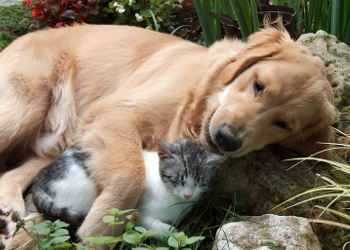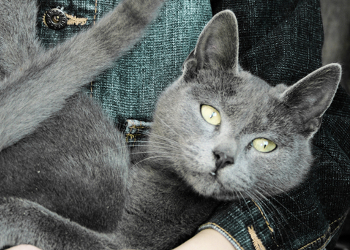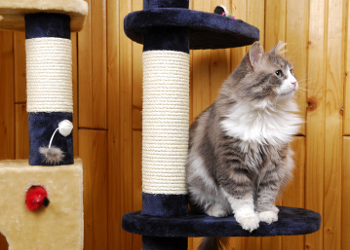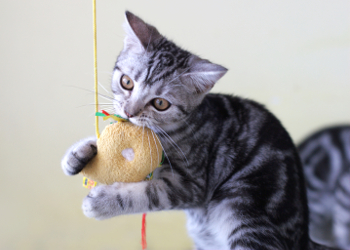Common Diseases & Conditions in Pets H

Canine Heartworm is a serious disease in dogs east of the Mississippi River and other subtropical, tropical parts of the world. It is found wherever mosquitoes are populous. It is common in areas with major annual rainfall. It is caused by the filarial worm, Dirofilaria immitis.
Dirofilia immitis is transmitted to dogs via a mosquito bite. A mosquito bites an infected dog and draws up microfilaria (immature worms) into its body. Three stages of worm development (L1, L2, L3) occur in the mosquito. They move up to the mouthparts of the insect within 30 days and are infective to dogs. A susceptible dog is bitten and stages L3-L5 occur with final development in the heart; particularly the right ventricle within 6-8 months of being injected by the mosquito. Worms often migrate to the right atrium, lungs and often liver causing clinical disease. Heart disease causes the majority of clinical signs in the dog. There may be one or multiple quantities of worms in the dogs heart. Males and females mate producing microfiliaria that will than be picked up by a mosquito on blood feeding. Cats can get heartworm but it is not that common. If infected, they usually have only about one worm in their hearts. Many are asymptomatic and are many times diagnosed only on post mortem.
Many dogs that are diagnosed with heartworm do not show any signs. That is quite common. Dogs with active heartworm infections are presented with a typical heart cough caused by the mechanical presence of the parasite in lung tissue. Dogs are often debilitated, thin and have difficulty breathing due to the parasite clogging up the right ventricle. Sort of like a blockage in a kitchen sink. Blood backs up and the heart can not pump efficiently. Animals do not have the energy to exercise. Some animals at this point may die of heart failure and collapse.
The occult heartworm test is the most commonly used test to diagnose Canine Heartworm disease. Years ago, the only test was examining a blood smear and look for the small wiggly microfiliaria. A lot of cases were missed. Some adults do not produce microfilaria. There may be 2 males or 2 female worms that can not mate yet cause clinical disease. These are the occult forms. Even if there are males and females in abundance with subsequent microfilarial development the occult test is the preferred way to go. One of the most commonly used test is the Idexx® Snap Heartworm RT Test. This is highly sensitive. In areas with Ehrlichiosis (Florida), Lyme Disease, Anaplamosis plus Lyme disease there is an Idexx® 4Dx Plus Test. All these tests detect surface antigens (proteins) that are found on the parasite. There may be false positives. If there are few parasites in the heart, there may not be enough antigen available to be detected. Antigen detection is only detected by the test on female worms. There could be numerous males and a negative test would be produced.
Once a heartworm dog is diagnosed a CBC and Chemistry profile are performed to judge the overall health of the animal before treatment is instituted. Radiographs or ultrasounds are performed and will normally show a enlargement of the right ventricle and dilitation of the pulmonary artery.
Diagnosis of heartworm disease is confirmed by a positive occult heartworm test. A history and physical findings lead the doctor to a presumptive diagnosis. There may also be murmurs heard during chest auscultation. Many of these dogs are young to middle aged and it is relatively unusual to pick up murmurs suggestive of primary heart disease in middle aged dogs.
Treatment occurs in several steps. In the first step the animal is given 2 injections of Immiticide® about 2 months apart that will kill adult heartworms. Prior to this, most dogs will be put on 2 weeks of Doxycycline to treat the potential bacteria, Wolbachia, that lives on the surface of the heartworm parasite. This is serious and animals are always hospitalized for this procedure and kept quiet. As the parasite dissolves it is possible for the pieces of the worm to act as emboli and cause pulmonary and or heart failure. It is absolutely crucial that the animal not be exercised or walked or excited for weeks after Immiticide® treatment. One month later the dog is treated to rid the body of circulating microfilaria. This is done by oral administration of ivermectins.
Some dogs may not be treated because of severe organ failure. Instead of treating those animals, the organ illness is addressed. Dogs that are treated may have clinical heart and or lung disease. Those conditions need to be addressed.
Economically, the treatment regimen is expensive. In South Florida, complete treatment is about $1500. Another good reason to have pet insurance! Some people can not afford the cost of heartworm treatment. Doing nothing will just allow that animal to serve as a source of infection. In those cases ivermectin administration, once a month, will at least clear the microfilaria so the animal is not infective to mosquitoes.
The prognosis for heartworm dogs once treated is very good. Once the adults and microfilaria are cleared the animal feels so much better. It has a lot more vigor and energy. The appetite returns and the animal gains weight back. Most animals have a satisfying outcome. A more guarded prognosis is given to those animals that were treated but have permanent heart and or lung disease.
The best bet is prevention. Not only will it save your dogs life but it is a heck of a lot cheaper to use preventative. Dogs six months of age and under but over 6-8 weeks of age can go straight on preventative as it is impossible to have heartworm disease at that age. Dogs over 6 months of age will require an occult heartworm test. If negative for screening, they are placed on year round monthly preventative. Years ago, there was just one preparation on the market. Heartgard® was the first to hit the market. Now a days there are countless brands available plus those combined with other products to kill fleas, ticks and other parasities. Your veterinarian can guide you through the process to select a preventative suitable for your family and pet.



Hepatic encephalopathy is a metabolic disorder caused by a secondary liver (hepatic) disease. The buildup of ammonia in the blood and associated central nervous clinical signs are hallmarks of the disease.
The liver is the largest gland in the body. It is a true manufacturing facility. It manufactures bile and albumin plus breaks down drugs and toxic substances into non-toxic metabolites. An exception to this is the problem with cats. They lack an enyzme, gluconyl transferase, that does not metabolize toxic products making cats extremely ill. A prime example of that is Tylenol® poisoning. In this case there is a congenital defect called a portosystemic shunt. Normally blood flows from the intestine via the portal vein to the liver where all the work is done breaking down harmful substances before entering the general circulation. A portosystemic shunt bypasses the liver allowing toxic substances such as ammonia to accumulate in the general circulation. Excess ammonia causes central nervous clinical signs. The most common cause is congenital but other diseases such as acute liver disease can lead to this problem.
Clinical signs commonly seen are: disorientation, bumping into objects, circling, wandering, personality changes, vomiting, orange colored urine amongst others. Animals may also howl and drink more water.
A CBC and Chemistry profile will usually detect elevation in the liver enzymes such as ALT and Alkaline Phosphatase. A urinalysis may show elevated bile pigments present (bilirubinuria). Radiographs or an ultrasound may show an abnormal shape to the liver which than dictates a liver biopsy. This will confirm the diagnosis.
A diagnosis of hepatic encephalopathy is suspected in dogs presented with central nervous signs and associated liver disease. A history and complete physical exam are crucial. Results of a liver biopsy confirm the diagnosis.
Treatment is geared towards regaining liver health as well as reducing the toxic ammonia absorbed from the intestinal tract. Many dogs are extremely ill when presented or even comatose. Liver treatment involves supportive care. Intravenous fluids are always given. Intravenous antibiotics and vitamins are administered. An esophageal feeding tube is inserted. Dietary requirements need to be met with a high quality protein diet. Hill’s® Prescription Canine l/d fits the bill. Other supportive care such as electrolytes will be monitored. Lactulose is an oral drug that is used to decrease serum ammonia levels. Lactulose is composed of galactose and fructose that are not digested. They pass to the colon where bacteria convert them into formic and acetic acid. This acidity forces water into the lower intestinal tract (hence its other function is a cathartic/laxative) and forces ammonia into the colon where the acidity converts straight NH3 into NH4 which is passed in the feces. Surgical repair may be attempted by a board certified surgeon.
The prognosis for hepatic encephalopathy is guarded and depends upon the initial presentation of the disease. If caught early and treated appropriately dogs do stand a chance. Relapses are possible and surgery is not always 100% effective. Animals presented comatose have a poor overall prognosis.



The liver is one of the most important organs in the body responsible for the buildup and breakdown of many chemicals needed for mammalian survival. Anything that interferes with the livers functioning can lead to general liver disease (hepatopathy). Liver diseases can be caused by: toxins, bacterial abscesses, viruses (Canine Adenovirus), ammonia buildup, gall bladder disease, immune-mediated diseases, Cushing’s Disease, Diabetes Mellitus, nodular hyperplasia amongst many more.
The hepatocyte is the basic cell in the liver. Interfering with its cellular function can degrade it causing individual cell death. Regardless of the causative agent, this cellular degradation can lead to focal or generalized liver disease with associated clinical signs.
Clinical signs result from primary or secondary liver disease. Primary liver disease is one where the primary cause is liver disease. Secondary disease is where the liver is injured secondary to a disease somewhere else in the body; such as Cushing’s Syndrome. Associated signs may involve: increased fluid consumption and urination, abdominal pain, distended abdomen, jaundice, anorexia, depression, lethargy, anemia, seizure activity amongst others.
A CBC and Chemistry profile are performed and will show an elevation of liver enzymes plus other abnormalities depending on the actual cause of liver disease. Radiographs and ultrasound procedures may show abnormalities in liver size or shape. Additional tests may be needed depending upon the causitive agent.
Diagnosis of a hepatopathy is based on historical and clinical evidence. Lab Work will confirm an initial diagnosis of liver disease. The difficulty is in finding the exact cause of that disease.
Unless an actual cause of liver disease is found, treatment of liver disorders involves supportive care. Many animals are presented extremely ill such as those suffering from Auto-Immune Hemolytic Anemia (AIHA). They need to be hospitalized and receive intravenous fluids and nutritional support. That involves correcting electrolytes and bleeding disorders plus providing fluid support to maintain renal and cardiac perfusion until an animal is able to drink and eat on its own. An esophageal feeding tube may be inserted. Other treatment may be required and dictated by the cause of liver disease. Once animals are able to keep food down, a high quality source of protein and vitamins are required. Hill’s® Prescription Canine l/d is recommended as well as Nutrical® gel. Once they are able to eat and drink on their own, dog and cats gain weight rapidly.
The prognosis for hepatopathy cases depends upon the severity of the condition (that is, clinical presentation) and the cause of the liver disease. All animals discharged will require periodic lab work follow ups as well as physical exams.



Hemorrhagic Gastroenteritis is a very common disease process in mainly dogs but also seen in cats. Broken down, this fancy word means a gastrointestinal infection with internal intestinal bleeding. Anything that causes irritation or cellular damage to the intestinal tract can cause this disease. Common causes are: viral infections (Parvo Virus) & sharp foreign bodies (needles, tacks). The majority of causes are unknown and may involve pancreatitis, immune-mediated disease amongst others.
In idiopathic (unknown) causes, the intestinal tract become leaky and permeable allowing blood and fluids to enter into the gastrointestinal tract. The mechanism is not exactly known but leads to the associated laboratory findings and clinical signs.
Affected dogs will pass a bright red, jelly like diarrhea as well as vomiting bile and mucous. Some animals may be presented in hypovolemic shock. The majority of these cases are seen in small tiny dogs such as Poodles, Yorkshire Terriers and Miniature Schnauzers. They may also have a fever.
A CBC and Chemistry profile are always done. This will be useful to detect electrolyte disturbances as well as other organ involvement. The usual lab presentation is a dog with an extremely high hematocrit of about 65%. The normal is around 37%-55%. Total serum proteins are also lowered due to the “leaky” nature of the intestinal tract.
Diagnosis of straight HGE is made by performing a lot of rule outs such as foreign bodies and Parvo Virus. A history, physical exam and classical laboratory findings can suggest a diagnosis of HGE. The only way to confirm it is via an intestinal biopsy.
Treatment is supportive for most HGE animals. Intravenous fluids with 5% Dextrose are always administered while the animal is hospitalized. Vomiting is controlled with Cerenia® and or famotidine and the diarrhea is controlled with aminopentamide and carafate. Animals are administered intravenous antibiotics plus vitamins to maintain health. Electrolytes are corrected. The goal is to get the animal to eat and drink on its own. Once that occurs, the dog is sent home on chicken and rice (or facsimile), antibiotics, Nutrical® gel and other supportive measures.
If aggressive treatment is thrown at the dog early, the prognosis is quite good even though a few of them may relapse some time in the future. Future exams and blood work may be needed as the animal convalesces.



A hermaphrodite is an individual that has a combination of both male and female organs or genitalia. It is relatively uncommon in dogs and cat. In my 33 year career, I only diagnosed one case of true hermaphroditism in a female Cocker Spaniel. It is presented in animals with an XX or XY combo chromosome pattern or just an XX.
Female animals have two chromosomes, XX. Males have 2 chromosomes, XY. A female develops in the absence of testosterone. It is the “default setting”. In the presence of testosterone (produced in the testes and adrenal cortex) a male will develop with an XY. In hermaphrodites this gets all jumbled up and can produce a myriad of combinations. Pseudohermaphrodites exist that have normal chromosomes but the external genital organs are different.
All sorts of combinations are possible. Females may develop an os penis in place of a clitoris yet have two ovaries or one ovary on one side and a testes on the other. Males may have testicles that have not descended into the scrotal sac. They may also have a vestigial uterus and or other internal female organs. None of these animals are capable of reproducing.
There are no specific lab tests to diagnose the disorder. Basic blood work such as a CBC and Chemistry profile may be performed since most animals are going to need to be neutered.
Diagnosis is suspected by the presence of abnormal external genitalia. Many times it may take years to figure out that an animal is a hermaphrodite. A key is the inability to reproduce or come into heat, if a female. A breeding male may not even have a sperm count due to the lack of testes or those retained in the inguinal canal or abdomen (cryptorchidism).
It is recommended that all hermaphrodites be neutered. You never know what you are going to see. In this Cocker Spaniel case I had in the early 1990’s, I told the owner I would “try” to spay the dog. The uterine horns were immature and wrapped around the bladder. In place of an ovary at each end of the uterine horn, was a testicle. This was confirmed by a histopathological diagnosis.
Prognosis is good and depends upon effective neutering of the animal in question.


Canine Hip Dysplaia is a genetic disorder associated with a defect in the formation of the hip joint. It is most commonly seen in German Shepherd dogs plus other large breeds of animals. Any dog can develop the condition but the majority are large animals.
In dogs affected with Canine Hip Dysplasia the angle of the femur and the pelvis is not correct. This malformation leads to an erosion of the femoral head and poor fit into the hip socket (acetabulum). This poor mechanical situation leads to inflammation and degregation of the hip joint in question. This degregation leads to the associated clinical signs of the disease. Hip Dysplasia is always exacerbated if the animal in question is obese. Excessive weight puts a tremendous amount of stress on ANY joint; let alone the dysplastic hip.
The presentation of clinical signs varies. Some animals may not show signs for years yet others will show signs at a young age of one or two. The most common clinical signs are: lameness in the affected limb, reluctance to walk or climb stairs, pain and difficulty getting up from a sleeping position. Many animals will walk shifting their weight from the bad hip to the normal one. In time, even that hip can get sore due to the extra weight that it is supporting.
All animals in this condition should have a CBC and Chemistry Profile performed to rule out other physical causes that may make an animal APPEAR to have hip issues but is not, due to the presence of referred pain. Radiographs are always performed to determine the severity of the dyplasia as well as looking for any lytic bone activity associated with bone cancers around the femoral area (osteosarcoma). Radiographs may also be analyzed by the Orthopedic Foundation for Animals (OFA).
Diagnosis of Hip Dysplasia is made by the history, breed presentation and clinical signs. Radiographs often confirm the diagnosis once other rule outs are made.
There is no cure for canine hip dysplasia. Current therapy can be: medical, surgical plus supportive care at home. Many animals are in acute pain so anti-inflammatories are prescribed such as Rimadyl®. In severe cases, animals may be given an appropriate dose of a corticosteroid for acute relief of signs. Either of these drugs will reduce inflammation and indirectly a lot of the associated pain. Some animals may require short term use of pain killers such as Tramadol®.
In animals that are obese, a weight loss program has to be instituted. Older dogs that are overweight may also be hypothyroid. In addition to a weight loss regimen, T4 and FT4 should be performed to rule out the thyroid issue.
Animals receive a tremendous boost and benefit from neutraceuticals that stimulate production of joint cartilage. One of the more popular versions is Dasuquin®. The loading period for this nutritional supplement is about 3 weeks. That is when most dogs start to show an improvement. By employing neutraceuticals, the veterinarian is often able to reduce or eliminate the dependence on anti-inflammatory drugs that almost always have an influence on liver function. All animals that are to be placed on Rimadyl® should always have their liver enzymes checked every 6 months while on the drug.
Some owners may elect a complete hip replacement. This is performed by a board certified orthopedic surgeon. The first procedure performed on a dog (and before humans) was done at The Ohio State University College of Veterinary Medicine.
Supportive care at home is important. Owners should do as much as possible about slippery tile or wood floors. Make sure the animals bedding is thick and comfortable. Employ a gate to keep animals from falling down stairs. Clinical signs of hip dysplasia are also exacerbated in climates that have wet, cold and damp weather. Move to Florida!
The prognosis for early detected Hip Dysplasia is very good particularly if an obese animal loses weight. As long as the thigh musculature stays firm and toned via mild exercise, the majority of animals can live a normal life. Animals that are weakened in severe, advanced cases are unable to stand up. These animals have a poor prognosis.


Hookworms are intestinal parasites that can cause anemia in pets. The hookworm is caused by Ancylostoma caninum.
Hookworms are small, thin, thread like parasites that are blood suckers. If you look at the parasite under a high powered microscope, the presence of 3 pairs of sharp teeth are visible in the head region. These head parts attach to the animals small intestinal tract and suck blood.
Hookworms are transmitted from dog to dog by the oral fecal route. Contaminated feces or water are ingested. The small larva is released from its egg. The larva grows as it is attached to the intestinal tract. Males and females mate and the life cycle starts all over again. The parasite can be transmitted from a pregnant mother to her unborn puppies or kittens. They can be further parasitized by ingesting the eggs while crawling over the mother during lactation or actual skin penetration by the larvae itself. Hookworm infections are most common in areas where dogs and cats are crowded together.
Young animals are more severely effected by hookworms. They are often found together with roundworms, coccidia or Giardia. Dogs and cats will have a dry, poor hair-coat. They will often be lethargic and small for their size. In severe cases pale gums and conjunctiva are present due to the anemia caused by the parasite. Hookworms have been known to cause fatalities in small animals.
A fecal flotation is done and the characteristic eggs, and varying larval development, will be seen on a microscope slide. They are too small to be visibly seen.
Diagnosis is made by the physical condition of the patients and confirmed by finding the eggs on a microscope slide.
Treatment of hookworms is by using pyrantel paste at two week intervals for 2-3 treatments. If other parasites are present, Panacur® powder is mixed in the food daily for 3 days. Either way, a repeat stool sample has to be examined to make sure the parasite is gone. If not, the pet gets retreated again. Animals that are anemic should be put on Pet-Tinic®, a liquid meaty flavored iron supplement.
The prognosis for hookworms infections are usually excellent. The key is prevention. Feces should be picked up in the yard as soon as possible to prevent infections or repeat infections. Females that are used for breeding should have a fecal exam done before the animal is bred. If parasitized, they should be treated so they do not transmit the parasite to their unborn or new born animals. Many beaches in this country do not allow pets for a good reason. Animals can pass hookworm eggs in their feces, the eggs hatch into larva and the larvae can penetrate the skin of humans. This is called cutaneous larval migrans. When puppies are two weeks of age, a stool sample from the mother and one of her pups or kittens should be examined for intestinal parasites.


Horner’s Syndrome is commonly seen in cats, not so much in dogs. It is characterized by damage to the sympathetic branch of the autonomic system. Clinical signs associated with this disease are seen in the eyes. Trauma to the nerve is one of the most common causes of Horner’s Syndrome. Car accidents are a leading cause of the problem.
The autonomic nervous system is responsible for functions that we have no control over or even think about. This includes: vision, hearing, the beating of our hearts and many more. It is most understood in the fight or flight mechanism which is hard wired into all mammalian life. The autonomic system is broken down into sympathetic and parasympathetic branches. In disease treatments, many pharmacological agents will stimulate or block one or the other systems to effect clinical signs. Damage to the sympathetic system seen in the eye is caused by damage to the nerve in the ear, eye or neck area.
Drooping of the eyelid, constriction of the pupil (miosis), sunken eye and protrusion of the third eyelid are signs almost always associated with Horner’s Syndrome.
Lab work entails a complete physical, eye exam, neurologic exam plus radiographs of the head and chest areas. History of prior trauma is crucial no matter how small it might be perceived to be.
Diagnosis is made by the presence of trauma and clinical signs in the animal. Other diseases cause similar signs and must be ruled out. They include facial nerve paralysis and facial muscle paralysis.
The majority of Horner’s Syndrome patients will stabilize and return to normal on their own. Due to the sympathetic nerve involvement, the animal may not be able to blink its eye. Tear supplements are prescribed to lubricate the cornea to minimize the development of corneal ulcers or kerititis sicca (dry eye). Phenylephrine (stimulates the sympathetic branch) is often used to dilate the pupil.
The prognosis for Horner’s Syndrome depends on the cause and severity of the lesions produced. Lesions due to trauma often respond quicker than those seen in other cases.


Hydrometra is the accumulation of a clear, serous fluid in the uterine horns in dogs and cats. It is caused by cystic hyperplasia of the uterine lining.
There is normal fluid production in the uterus during estrous (when the animal is in heat). There is an outflow or drainage problem associated with this gynecological issue. Like a sink that is stopped up, fluid will accumulate in the uterine horns. I have had one case in my career.
There may be a clear, serous vaginal discharge a month or so after estrous. If the discharge is mucoid, this condition is known as mucometra. The discharge will not be purulent or contain pus cells (like pyometra). Sometimes there are no clinical sign and the veterinarian will trip over the condition when an animal is presented to be spayed.
If a vaginal discharge is present, staining it will show no cellular debris. If the abdomen is distended, a radiograph or ultrasound is performed to check for pregnancy or some fluid contained in the uterus. A CBC and Chemistry profile are performed to rule out pyometra.
The presentation of a unaltered female several months after estrous with a clear vaginal discharge and or enlarged uterine horns can lead to a tentative diagnosis of hydrometra. Differentiation from pyometra is made by lacking a pus containing vaginal discharge containing neutrophils and lack of clinical signs of lethargy and excess fluid intake. Pyometra dogs will have a left shift neutrophilic leukocytosis while hydrometra dogs will not.
Treatment for hydrometra is spaying the animal in question. The procedure is curative and will prevent other female gynecological problems from happening in the future.
The prognosis for hydrometra cases is excellent. Once spayed, animals live a normal life. Animals can apparently live with the condition; as the middle aged dog I spayed years ago had the condition for an unknown period of time prior to surgery.


The parathyroid glands are located on or near the thyroid glands in the neck area near the larynx (voice box). The cause of this condition has not been documented in animals but could have a neoplastic, genetic, drug induced or auto-immune component
The parathyroid glands regulate blood levels of calcium and phosphorus. When levels get low, parathyroid hormone is stimulated and bone calcium is absorbed into the general circulation. With insufficient production of the hormone, blood calcium levels decrease. This is called hypocalcemia and can lead to severe neurological signs such as seizures and tremors. Insufficient hormone production can also occur if the thyroid glands are removed; taking the parathyroid glands with it.
Signs associated with hypoparathyroidism are neurological in nature. Animals may act disoriented, weak, stumble, seizure, have a fever, twitch and walk stiff as if suffering from arthritis.
A CBC and Chemistry profile are performed. It will show low serum calcium levels and high serum phosphate levels. A PTH assay test to actually measure the level of parathyroid hormone present is diagnostic.
A history and associated clinical signs plus lab work will aid in the diagnosis of hypoparathyroidism. Many dogs are staggering or in full blown seizures. These need to be differentiated from other diseases such as: true idiopathic or toxin related seizures, hypoglycemia caused by a pancreatic insuloma, hypoglycemia seen in diabetics given too much insulin and other causes.
Once the condition is diagnosed, the immediate goal is to raise the serum calcium levels back to a more normal level and stop seizure activity. The former is accomplished by intravenous injections of calcium gluconate. The latter, by intravenous doses of diazepam. Animals are hospitalized and stabilized with other necessary supportive care. Once the animal is stabilized, vitamin D and oral calcium are provided. Vitamin D has a sole function of facilitating the absorption of calcium from the gut. Animals have to be hospitalized initially for this since it takes about 3-4 days for oral calcium supplements to take effect. In the mean time animals will need parenteral administration of calcium gluconate. Once discharged, blood work and repeat physical exams are necessary.
The prognosis for parathyroid hormone deficient animals is very good as long as it is diagnosed and treated early, as well as maintained on adequate replacement therapy.


Hypothermia is a severe drop in an animal’s corporal body temperature. If temporary, the shivering reflex starts to warm the animal up. In severe cases, it can cause death. Common causes of hypothermia are prolonged exposure to extremely cold outdoor temperatures or cold water for a prolonged period of time. Lowering of corporal body temperatures leads to depression of the central nervous system and vital organs.
Newborn animals may suffer hypothermia right after birth and need to be warmed and stimulated. The young and the old are most susceptible to hypothermia and those animals with a pre-existing medical condition such as congestive heart failure. Dogs and cats without hair will also be more susceptible. The Chinese Crested dog and the Sphinx cat are examples.
Years ago, I treated a Miniature Schnauzer that got stuck in a snow bank and could not get out. It was in that predicament for numerous hours until the owner found the dog. It survived with medical care.
Normal canine and feline body temperatures are about 102.0 F. Hypothermia exists in three stages, with each stage leading to worsening conditions due to an increasingly lower body temperature. Below 96 or so degrees, the shivering reflex stops and if the tide is not corrected, the animal will slip into an eventual coma and perish due to organ failure. With each passing second, lower body temperatures slow down the heart and respiratory rate plus brain activity. The kidneys do not receive adequate blood supply and so on. It is a vicious cycle that results in a complete, total body shutdown.
Clinical signs seen vary with the extent of exposure to cold weather as well as the temperature of the animal when presented. Initially, animals will have a somewhat lower body temperature around 100.0 F. Dogs or cats will often shiver uncontrollably. This is a survival mechanism causing muscular contractions that generate heat. As the condition worsens, animals will have shallow respiration and slow chest movements. They will be weak and or stagger around. In severe cases, animals are completely recumbent or in a coma like condition.
Lab work is usually reserved for animals that have suffered severe hypothermia. A CBC and a Chemistry profile may show concurrent organ failure.
Diagnosis of hypothermia is usually made by a history of exposure to cold air or water temperatures plus physical findings of a sub-normal body temperature and associated clinical signs.
Treatment is geared to slowly raising the body temperatue and associated clinical signs due to hypothermia. Mildly affected animals may just require a physical exam and sent home to sit by a wood burner and wrapped in blankets! Other animals will need to be hospitalized to jump start the body temperature and circulatory system. This is done by infusing warm fluids via an intravenous catheter, covering the animal in blankets and getting the animal to the point where the shivering reflex kicks in. The animal is closely monitored until vital signs and the core body temperature return to normal. Further blood work may also be needed to make sure renal function has been normalized.
The prognosis for those animals receiving immediate care for hypothermia is excellent. Animals presented comatose or in renal failure have a much more guarded prognosis.
Prevention is the key. Minimize exposure to cold temperatures. Keep pets dressed in canine coats and watch them when outside in cold weather. Labradors will try to swim in any water that is not frozen. If you have a pond, monitor it. Newborn animals have to be kept warm. For the first 2 weeks, dogs and cats can not control their body temperature. They are like reptiles during that period. Keep them in a brood box at about 100.0 F. Surgical patients can suffer from hypothermia but all veterinarians take care of that by placing warm circulating water jackets, blankets and or warm water bottles around the animal during surgery.


Hypothyroid is a common disease in older, larger breeds of dogs. Deficiency of thyroid hormones alter the metabolic rate of the animal and can cause general malaise and other issues. The cause is cellular destruction of thyroid tissue. This may be associated with an auto-immune response in the thyroid gland.
The thyroid glands are 2 lobed glands located on each side of the neck by the larynx (voice box). The gland is under control of the pituitary gland. The pituitary gland produces Thyroid Stimulating Hormone (TSH) that causes production of thyroid hormone in the thyroid gland. The two thyroid hormones are T3 and T4. T4 is converted to T3 and the latter is the active hormone. There may be conversion issues in dogs but that is not too common. The numbers after the “T” denote the number of iodine molecules attached. Deficiency in production causes signs of hypothyroidism.
General clinical signs of hypothyroid activity are: lethargy and malaise, weight gain, seborrhea sicca or other dry flaky skin issue, intolerance to cold weather and off and on skin infections.
There are numerous ways to diagnose hypothyroidism in the dog. Cats rarely have deficient thyroid activity.
1. Measurement of both T4 and FT4: The latter is thyroid hormone that is not protein bound. It is used in conjunction with T4 levels to diagnose the condition.
2. TSH Test: In this test a small amount of thyroid stimulating hormone is administered IV. Six hours later blood will be drawn to detect the amount of T4 in the blood. In primary hypothyroid dogs, T4 is not elevated. In normal dogs, it is.
A CBC and Chemistry profile will be drawn to verify organ functioning, making sure the thyroid condition is not secondary to another condition. Cushing’s Syndrome dogs will have a depressed thyroid function due to the effect of corticosteroids in the body (cortisol). In those cases the thyroid issue is not treated as it will return to normal once the Cushing’s is treated with Trilostane® or Lysodren®.
Diagnosis of hypothyroidism is made by historical and physical findings. Combined with laboratory work such as a TSH test or measuring T4 and FT4, either or both will give a diagnosis of thyroid deficiency.
Treatment of hypothyroidism is geared towards hormone replacement therapy and correcting any pyoderma or seborrhea conditions present. Supplementation with levothyroxine administered twice daily is the treatment of choice in the dog. In several weeks the dog feels better and is much more alert. A month or two later, the lab tests are repeated and adjustments are made to the thyroid dose, if necessary. Once stable, thyroid levels are usually checked twice a year. Skin conditions usually require numerous weeks of antibiotic therapy and shampoos containing chlorhexidine or ketoconazole. Dogs will need to be on hormone replacement therapy for life.
The prognosis for treated hypothyroid animals is excellent. They can continue to live a robust, active life as long as they receive daily doses of levothyroxine. Always make sure you have plenty of medication left before traveling with the animal or over a long holiday weekend.


Hyperparathyroidism is a disease most commonly seen in older dogs and not so common in cats. It is characterized by the production of excess parathyroid hormone. It is grouped into 3 different types:
1. Primary Hyperparathyroidism: This is caused by a tumor (adenoma) of the gland.
2. Secondary (nutritional) Hyperparathyroidism: This is caused by a diet that is insufficient in calcium. This is commonly seen in dogs that are fed a strict meat only diet.
3. Secondary (renal) Hyperparathyoidism: This is seen in renal disease where phosphate levels rise and renal production of calcitreol drops. As a result, excess parathyroid hormone is produced.
1. Primary Hyperthyroidism: In this case a tumor causes production of excess parathyroid hormone. This causes an elevation in serum calcium levels and associated clinical signs.
2. Secondary (Nutritional) Hyperparathyroidism: After being on a strict meat only diet or lack of calcium in the diet. Meat will have excess phosphorus but insufficient calcium. This throws the Calcium/Phosphorus ratio out of whack. Extra parathyroid hormone is produced and calcium is taken out of bone tissues resulting in a weakening of the bone structure.
3. Secondary (renal) hyperparathyroidism: With an increase in phosphorus (due to renal failure) and stimulation of parathyroid hormone, renal function and bone depletion of calcium is made even worse. With calcium depletion and the presence of excess phosphorus, animals will develop “rubber jaw“, a severe weakening of the mandible that can lead to fractures due to calcium depletion and excess phosphorus.
The majority of dogs with primary hyperparathyroidism do not show any clinical signs. An elevated serum calcium will be noted. In mild cases, the dog will drink more and urinate more. Anorexia and lethargy will occur but than again, those are general signs of the majority of diseases. In secondary (nutritional) hyperparathyroidism clinical signs produced are poor development of the spinal vertebrae plus an awkward gait due to calcium bone depletion and poor bone development. Young animals are also more prone to fractures due to the poor calcium bone matrix present. In secondary (renal) hyperparathyroidism, signs of chronic renal failure are present such as excessive thirst and urination and the production of a dilute urine.
A CBC and Chemistry profile are performed. In primary hyperparathyroidism, serum calcium levels will be elevated. Ultrasound imaging will be performed to look for parathyroid tumors. Profiles will also show elevated serum phosphorus and signs of renal failure in suspect Secondary (renal) hyperparathyroidism dogs. In Secondary (nutritional) hyperparathyroidism the calcium levels will be low with adequate phosphorus due to inadequate calcium in the diet.
Diagnosis of the primary cause is made by physical exam, lab work and the finding on ultrasound of a tumor on the parathyroid gland. The secondary (nutritional) cause is made by the presence of a young animal with a deformed skeleton and the presence of fractures in young animals. The history of feeding an exclusive meat diet is of utmost importance in the diagnosis. The secondary (renal) cause is made by looking at lab work indicative of chronic renal failure or rubber jaw. Bone depletion also occurs in these cases. Hyperparathyroidism is so common in chronic renal failure dogs that it should always be thought of when dealing with the renal failure.
1. Primary Hyperparathyroidism: Treatment is geared towards surgical removal of the adenoma. Care must be taken post op in monitoring calcium levels. Some animals serum calcium will drop precipitously and must be give intravenous calcium gluconate and discharged on oral calcium supplementation. Oral products take about 3 days to raise serum calcium so animals will have to hospitalized until the level rises.
2. Secondary (nutritional) Hyperparathyroidism: Treatment is by putting the dog on an appropriate diet with nutritional supplements such as Nutrical®. The animal must be removed from an all meat diet. Any skeletal deformities are irreversible.
3. Secondary (renal) Hyperparathyroidism: The goal is reversing or controlling chronic renal failure. This is difficult. Offering phosphate binders such as Aluminum Hydroxide will help to lower serum phosphates. Diets lower in phosphorus will also help. Hill’s® Prescription Canine k/d is a good choice.
The prognosis for primary hyperparathyroidism is good and depends upon the surgical removal of the adenoma and proper regulation of serum calcium. The prognosis for the secondary (nutritional) hyperparathyroidism is very good once the animal is placed on a nutritionally balanced diet. The prognosis for secondary (renal) hyperparathyroidism is guarded since the main problem is correcting chronic renal failure which is difficult.


Hyperthermia is a life threatening condition in dogs and cats. It is defined as an excessive elevation in the corporal body temperature due to excessive environmental heat. This is seen much more commonly in dogs and almost never in cats. Cats sleep most of the day when it is hotter and are more active at night when temperatures have cooled off. Hyperthermia is different from fever. Fever is a elevation in body temperature secondary to a viral or bacterial presence in the animal. Fever of Unknown Origin (FUO) is a fever not caused by bacteria or viruses but more commonly by auto-immune diseases or certain cancers.
A dog or cat normal body temperature is around 102.0 F. Hyperthermia leads to signs of heat exhaustion and heat stroke. It is not just the environmental heat that causes problems but the humidity present at the same time. I have had dogs suffer heat stroke even though the temperature was in the mid 80’s but the relative humidity was even higher. Heat related illnesses always occur during warm weather. In Florida, that means year round. Leaving animals outdoors without shade or water, in cars with windows rolled up and even taking a dog for a walk in mid day sun can send an animal over the edge.
Dogs can not perspire like humans or horses. The only exception to that rule is the Chinese Crested dog. It has sweat glands on its skin. Sweat helps to wick heat away and attempt to cool the body temperature. Dogs and cats only have sweat glands at the base of each foot pad. Totally inadequate. A dog or cats response to eliminating heat is by panting. Excessive saliva is produced which will wick away respiratory heat but this system easily gets overloaded compared to humans. This explains all the clinical signs seen.
Clinical signs of hyperthermia vary with the severity of the condition. In early stages, the dog will pant and its heart rate and respiratory rate will increase. As the condition worsens, the animal becomes weak, lethargic and disoriented. If not corrected vomiting and a blood tinged diarrhea may occur. Extreme heat stroke can be fatal. Dogs will seizure due to brain swelling. That seizure activity makes the heat stroke worse since seizures cause muscle contractions which produce more heat. That is the last thing a dog needs! The dog will go into renal failure plus clotting difficulties such as DIC (Disseminated Intravascular Coagulopathy) will usually occur. The blood figuratively boils. Animals in this latter state rarely survive. Early heat stroke will produce a rectal temperature of between 104.0 F-105.0 F. Severe heatstroke signs develop when the corporal body temperature is over 107.0 F.
A CBC and Chemistry profile are always performed. In advanced cases the BUN and Creatinine will be elevated indicating renal failure. Checking a blood sample for clotting time is crucial. The hematocrit will usually show a dehydration effect, that is it will be quite elevated above normal.
A diagnosis of hyperthermia and heat stroke are made based on the history of an animal trapped in excessive heat and or humidity conditions as well as an extremely high rectal temperature. The time of the year (in temperate climates) will lead to suggest it as the primary cause.
Treatment goals are the immediate decrease of the corporal body temperature. At home, if owners suspect a heat stroke case, is to hose off the animal with water and wrap a water soaked blanket around the animal and seek immediate medical attention. In the hospital blood will be drawn and intravenous fluids to correct shock, dehydration and renal function. Usually dogs are flushed with cold water until the body temperature reaches about 103.5 F. At that time the temperature will slowly glide down to about 100.0 F- 101.0 F where the shivering reflex will raise it back to normal. Water is initially sprayed towards the base of the lower brain stem. This is the closest point between the exterior of the body and the hypothalamus. This is the body’s main thermostat so applying water directly in the vicinity will help lower body temperatures. In mild cases animals usually respond quickly. In severe cases, seizures are controlled by diazepam. Dogs that suffer from acute renal failure are hospitalized until serum chemistries are normal, urine output has improved plus the animal is alert and eating and drinking on its own. DIC can be handled with heparin but it is risky business treating it.
The prognosis for the majority of hyperthermia cases is excellent once medical care is sought and promptly treated. Prognosis for animals suffering from secondary seizures, renal failure and DIC is more guarded. The successful treatment of those secondary issues dictate the overall survival of the animal.
Prevention is the key. Never leave animals in cars alone with the windows rolled up. Do not leave the pet without water or shade if left outside. The cooling mechanism naturally found in dogs and cats is far inferior to that of humans. An animal will do better in extreme cold situations than extreme hot, humid situations. In hot weather, keep the animal in an air conditioned environment. If you usually walk the dog, do so in the early morning or evening. DO NOT ride a bicycle and have a dog tethered to it making it run in hot weather. That is a guarantee to develop heat exhaustion.


Hyperthyroidism is the most commonly seen endocrine disease in the older cat. Most cats are about 10 years of age and older when diagnosed with the condition. Hyperthyroid is caused by excessive thyroid hormone by one or both of the thyroid glands.
Thyroid hormone influences practically every function in the body. It is crucial for the animals mental, alert state. Skin condition, maintenance of body weight, heart and respiratory rate are under its control. The thyroid glands are two lobed glands located on each side of the larynx (voice box).
When excess thyroid hormone enters the blood system, all body systems go into “over drive”. The clinical signs seen arise from this excess hormone production.
The majority of cats are over 10 and in my Ohio practice all of the cats were black in color! Excessive thirst, urination, weight loss, nervous activity, poor coat condition, increased appetite and irritability are the main signs seen in cats.
In advanced cases, excess thyroid hormone will lead to feline hypertrophic cardiomyopathy. Cats presented with signs of hyperthyroid may also have murmurs present and actual signs of congestive heart failure if the heart is dilated.
When suspecting feline hyperthyroidism, a CBC and Chemistry profile are performed to analyze metabolic bodily functions. The crucial test that determines the condition is the T4 and FT4 thyroid tests. If the T4 is elevated and the FT4 is not, wait on a diagnosis and repeat the test later. If the FT4 is elevated, the T4 will usually also be up and a diagnosis of hyperthyroid can be made. There are cases where you know the cat is hyperthyroid but the lab tests do not confirm it. Wait 3-6 months and repeat the thyroid tests. The majority of the times the values will be elevated. That is just being “a cat”. Cats always try to outfox veterinarians.
If secondary hypertrophic cardiomyopathy is suspected, a cardiac ultrasound and an Idexx® Pro-BNP test are recommended.
A diagnosis of hyperthyroidism is made by taking into account the historical findings, the age of the cat and physical exam. The thyroid function tests will confirm the diagnosis.
There are many causes of excess thirst, urination and weight loss in pets. The prime rule out here is Diabetes mellitus. It is characterized by concurrent hyperglycemia and glucosuria. Chronic liver disease will have elevated liver enzymes and altered metabolites present. Chronic renal disease will have elevated BUN, Creatinine and Phosphorus. The urine produced is dilute. These all differ from feline hyperthyroidism.
Treatment is geared towards lowering the thyroid hormones back into a normal range. This can be accomplished three ways:
1. Putting the animal on Tapazole® (methimazole), on an initial loading dose and maintenance dose, will lower the thyroid hormones back to a normal range in a few weeks. The drug prevents the formation of thyroid hormones. The disadvantage to this: cats hate to be pilled. Independent compounding labs are able to manufacture a paste that is applied daily to the ear flaps. Use gloves when applying this to the animal’s ears. This replaces oral therapy. It is a daily life long commitment and if therapy stops abruptly the thyroid hormones will resume their climb back to excessive levels. Problem is, is that long term use of the drug does not stop the thyroid adenomas from growing. T4 and FT4 levels have to be checked frequently until the cat is stabilized and than twice a year.
2. Surgical removal of the thyroid glands. This is straight forward but the big problem is that the parathyroid gland is diffuse and can not be differentiated visually from the thyroid gland in the cat. There may be future serum calcium issues.
3. Radioactive Iodine. This is a costly procedure but it is a one time treatment in the cat. Methimazole is not cheap so the cost over the life time of the cat is more reasonable. It requires no anesthesia and the drug is administered subcutaneously. This procedure is only performed in facilities that have a special license. Animals are all hospitalized. Great thing is, is that thyroid hormone levels reach normal limits in a week or two.
Cats that have developed secondary cardiomyopathy will need to be treated for that disease.
The prognosis for most cats treated for feline hyperthyroidism is very good. Seeing an animal go from a wasted, gaunt condition to a thriving older cat is rewarding. Long term prognosis is based on the development of the thyroid adenoma as well as the long term treatment that had been decided on. Long term survival is better with radioactive iodine than methimazole for the simple reason that in the latter, the tumor growth is not inhibited.

